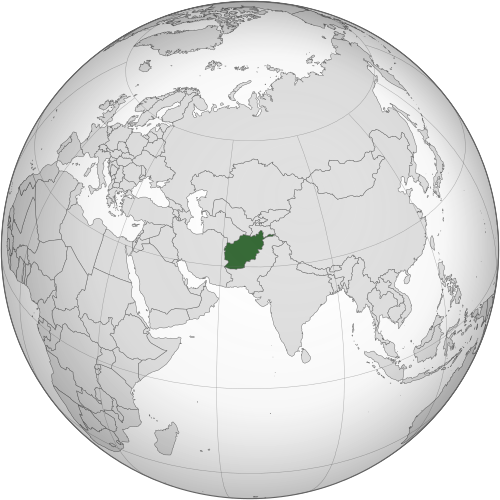 The Islamic Republic of Afghanistan is a landlocked country in south-central Asia. It is bordered by Pakistan in the south and east, Iran in the west, Turkmenistan, Uzbekistan and Tajikistan in the north, and China in the far northeast. In addition; India claims a border with Afghanistan at the Wakhan corridor as part of its claim on the Gilgit-Baltistan region of Kashmir currently controlled by Pakistan.
The Islamic Republic of Afghanistan is a landlocked country in south-central Asia. It is bordered by Pakistan in the south and east, Iran in the west, Turkmenistan, Uzbekistan and Tajikistan in the north, and China in the far northeast. In addition; India claims a border with Afghanistan at the Wakhan corridor as part of its claim on the Gilgit-Baltistan region of Kashmir currently controlled by Pakistan.
The territories now comprising Afghanistan have been an ancient focal point of the Silk Road and human migration. The land is at an important geostrategic location, connecting East, South, West and Central Asia, and has been home to various peoples through the ages. The region has been a target of various invaders since antiquity, including Alexander the Great, the Mauryan Empire, Muslim armies, and Genghis Khan, and has served as a source from which many kingdoms, such as the Greco-Bactrians, Kushans, Samanids, Ghaznavids, Ghurids, Timurids, and many others have risen to form empires of their own.
The political history of Afghanistan begins in the 18th century with the rise of the Pashtun tribes (known as Afghans in Persian), when in 1709 the Hotaki dynasty established its rule in Kandahar and, more specifically, when Ahmad Shah Durrani created the Durrani Empire in 1747 which became the forerunner of modern Afghanistan. Its capital was shifted in 1776 from Kandahar to Kabul and most of its territories ceded to neighboring empires by 1893. In the late 19th century, Afghanistan became a buffer state in “The Great Game” between the British and Russian empires. On August 19, 1919, following the third Anglo-Afghan war, the country regained independence from the United Kingdom over its foreign affairs.
Since the late 1970s Afghanistan has experienced a continuous state of civil war punctuated by foreign occupations in the forms of the 1979 Soviet invasion and the October 2001 US-led invasion that overthrew the Taliban government. In December 2001, the United Nations Security Council authorized the creation of an International Security Assistance Force (ISAF) to help maintain security and assist the Karzai administration. The country is being rebuilt slowly with support from the international community and dealing with a strong Taliban insurgency.
The area was part of the Persian Achaemenian Empire in the 6th century BCE and was conquered by Alexander the Great in the 4th century BCE. Hindu influence entered with the Hephthalites and Sasanians. Islam became entrenched during the rule of the Saffarids, c. 870 CE. Afghanistan was divided between the Mughal Empire of India and the Safavid empire of Persia until the 18th century, when other Persians under Nadir Shah took control. Britain fought several wars in the area in the 19th century. From the 1930s the country had a stable monarchy, which was overthrown in the 1970s. Marxist reforms sparked rebellion, and Soviet troops invaded. Afghan guerrillas prevailed, and the Soviets withdrew in 1989.
In 1992 rebel factions overthrew the government and established an Islamic republic. In 1996 the Taliban militia took power in Kabul and enforced a harsh Islamic order. The militia’s unwillingness to extradite extremist leader Osama bin Laden and members of his al-Qaeda militant organization following the September 11 attacks in 2001 led to military conflict with the U.S. and allied nations, the overthrow of the Taliban, and the establishment of an interim government.
Afghans display pride in their religion, country, ancestry, and above all, their independence. Like other highlanders, Afghans are regarded with mingled apprehension and condescension, for their high regard for personal honor, for their clan loyalty and for their readiness to carry and use arms to settle disputes. As clan warfare and internecine feuding has been one of their chief occupations since time immemorial, this individualistic trait has made it difficult for foreign invaders to hold the region.
Buzkashi is a national sport in Afghanistan. It is similar to polo and played by horsemen in two teams, each trying to grab and hold a goat carcass. Afghan hounds (a type of running dog) also originated in Afghanistan.
Agriculture is the main occupation, although less than 10% of the land is cultivated; a large percentage of the arable land was damaged by warfare during the 1980s and 90s. Largely subsistence crops include wheat and other grains, fruits, and nuts. The opium poppy, grown mainly for the international illegal drug trade, is the most important cash crop. The country is the world’s largest producer of opium, and of hashish, obtained from hemp (cannabis); both are produced especially in S Afghanistan. Grazing is also of great importance in the economy. The fat-tailed sheep are a staple of Afghan life, supplying skins and wool for clothing and meat and fat for food.
Notes from Wikipedia and Answers.com









